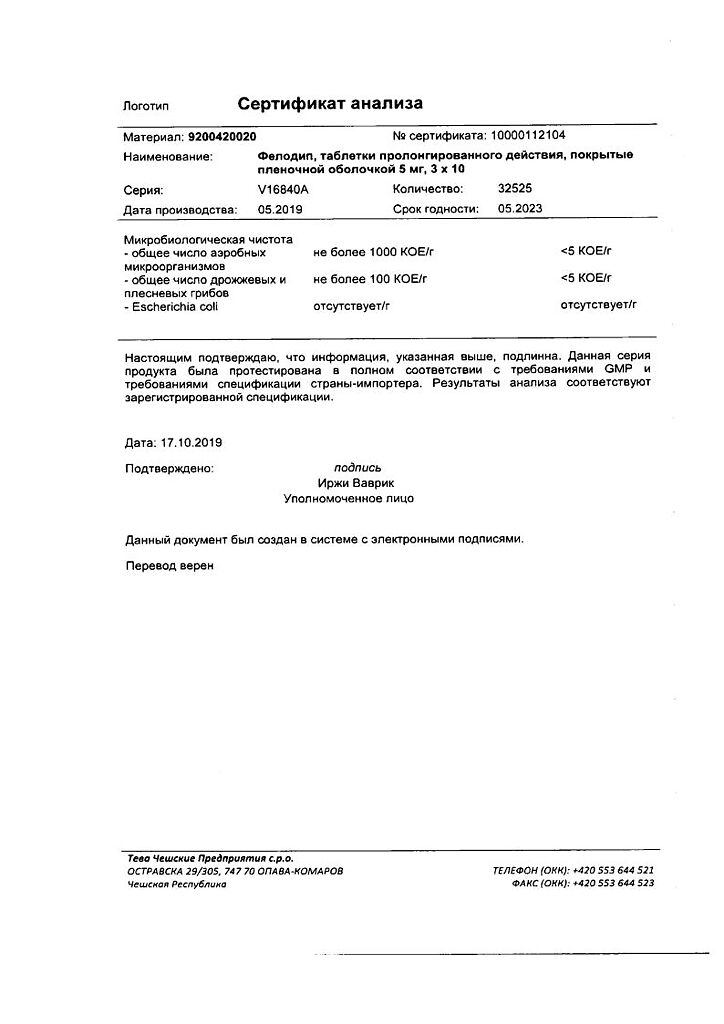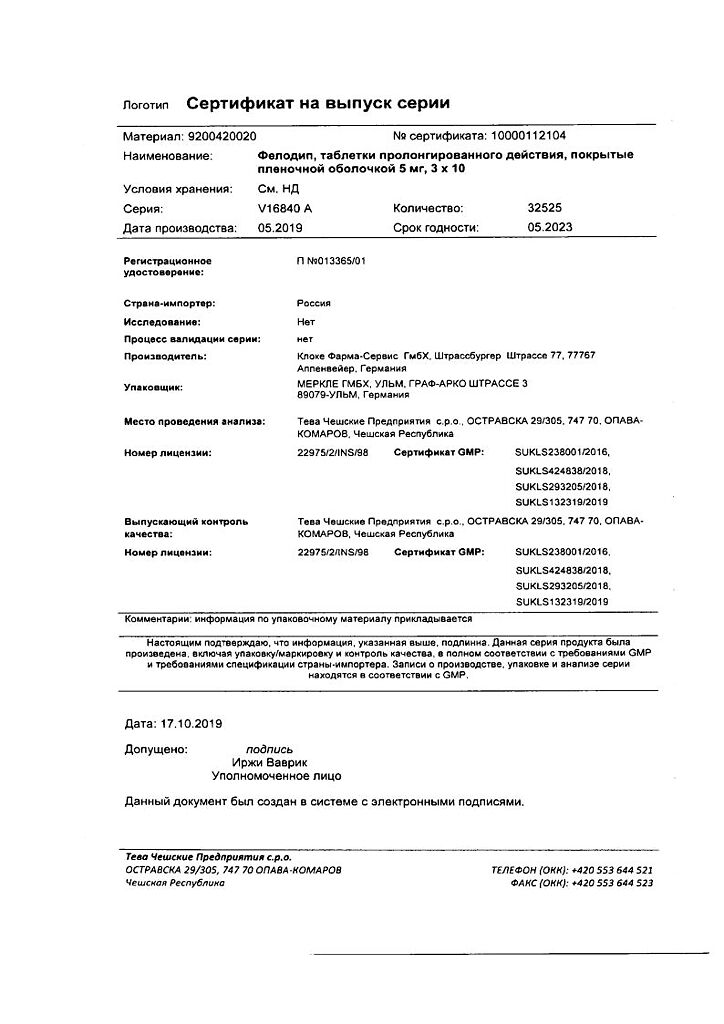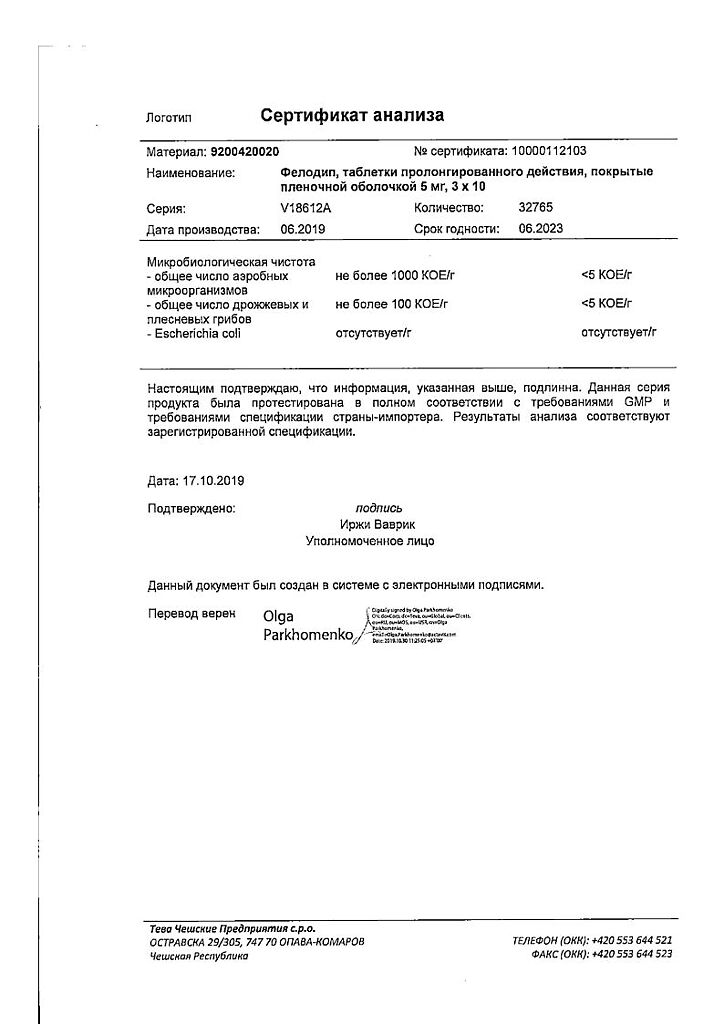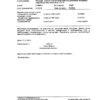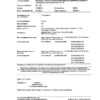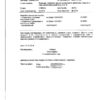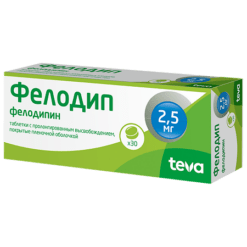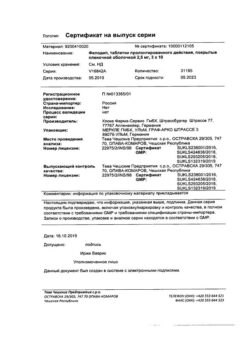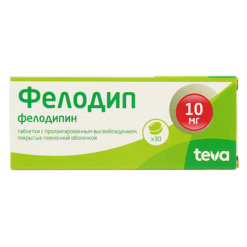No products in the cart.
Felodip, 5 mg 30 pcs
€19.34 €16.12
Description
Felodipine refers to BCCs of the dihydropyridine series. It has hypotensive and antianginal action. Reduces BP by reducing peripheral vascular resistance. It has a dose-dependent anti-ischemic effect. Reduces the size of myocardial infarction, protects against reperfusion complications. It has practically no negative inotropic effect and has minimal effect on the cardiac conduction system.
Pharmacokinetics
Intake and distribution. Delayed release of felodipine from film-coated tablets leads to prolongation of the phase of drug absorption and ensures uniform concentration of felodipine in blood plasma within 24 hours. Felodipine is almost completely absorbed in the gastrointestinal tract. Bioavailability of the drug does not depend on the dose within the therapeutic interval and is approximately 15%. 99% of felodipine is bound to blood plasma proteins, especially to albumin.
Metabolism and excretion. Felodipine is completely metabolized in the liver, and all its metabolites are inactive.T1/2 of felodipine is 25 h. There is no cumulation of felodipine with prolonged use.
Pharmacokinetics in special groups of patients
Elderly patients. In elderly patients and in cases of impaired liver function, plasma concentrations of felodipine are higher than in younger patients.
Kidney function impairment. Pharmacokinetic parameters of felodipine do not change in patients with impaired renal function, including those under hemodialysis. About 70% of the administered dose is excreted by the kidneys and the rest by the intestine in the form of metabolites. Less than 0.5% of the administered dose is excreted unchanged by the kidneys. Felodipine penetrates through the placenta and is excreted with breast milk.
Indications
Indications
– Arterial hypertension (in monotherapy or in combination with other antihypertensive agents such as beta-blockers, diuretics or ACE inhibitors).
– Stable angina (in monotherapy or in combination with beta-blockers).
Pharmacological effect
Pharmacological effect
Pharmacotherapeutic group: blocker of “slow” calcium channels.
ATX CODE: C08CA02
Pharmacological properties
Pharmacodynamics
Felodipine belongs to the blockers of “slow” calcium channels of the dihydropyridine series. Has a hypotensive, antianginal effect. Reduces blood pressure (BP) by reducing peripheral vascular resistance. Has a dose-dependent anti-ischemic effect. Reduces the size of myocardial infarction and protects against complications of reperfusion. It has virtually no negative inotropic effect and has minimal effect on the conduction system of the heart.
Pharmacokinetics
Suction and distribution
The slow release of felodipine from film-coated tablets leads to a prolongation of the absorption phase of the drug and ensures a uniform concentration of felodipine in the blood plasma over 24 hours. Felodipine is almost completely absorbed from the gastrointestinal tract. The bioavailability of the drug does not depend on the dose within the therapeutic interval and is approximately 15%. 99% of felodipine binds to blood plasma proteins, primarily albumin.
Metabolism and excretion
Felodipine is completely metabolized in the liver, and all its metabolites are inactive. The half-life of felodipine is 25 hours. With long-term use, felodipine does not accumulate.
Pharmacokinetics in special groups of patients
In elderly patients and in cases of liver dysfunction, the concentration of felodipine in the blood plasma is higher than in young patients. The pharmacokinetic parameters of felodipine do not change in patients with impaired renal function, including those undergoing hemodialysis. About 70% of the dose taken is excreted in the urine, and the rest in the feces in the form of metabolites. Less than 0.5% of the dose taken is excreted unchanged in the urine. Felodipine penetrates the blood-brain barrier into the placenta and is excreted in breast milk.
Special instructions
Special instructions
The drug Felodip, as well as other vasodilators, can in rare cases cause significant arterial hypotension, which in some predisposed patients can lead to the development of myocardial ischemia. Currently, there is no data on the advisability of using the drug as secondary prevention of myocardial infarction.
The drug Felodip is effective and well tolerated by patients regardless of gender and age, as well as by patients with concomitant diseases such as bronchial asthma and other lung diseases; impaired renal function; diabetes mellitus; gout; hyperlipidemia; Raynaud’s syndrome, as well as after lung transplantation.
Felodip has no effect on blood glucose concentrations and lipid profiles.
Impact on the ability to drive vehicles and work with equipment
Patients who experience weakness or dizziness during treatment with Felodip should avoid performing activities that require increased concentration and speed of psychomotor reactions.
Active ingredient
Active ingredient
Felodipin
Composition
Composition
1 tablet contains:
active ingredient: felodipine 2,500 mg/5,000 mg/10,000 mg; excipients: lactose monohydrate 25.200 mg/23.950 mg/21.450 mg; microcrystalline cellulose (type Avicel PH 101) 51,750 mg/50,500 mg/48,000 mg; hypromellose (Methocel E50LV) 110,000 mg/110,000 mg/110,000 mg; povidone (type K-25) 7.350 mg/7.350 mg/7.350 mg; propyl gallate 0.067 mg/0.067 mg/0.067 mg; microcrystalline cellulose (type Emcocel 90 M) 8,000 mg/8,000 mg/8,000 mg; colloidal silicon dioxide 1,300 mg/1,300 mg/1,300 mg; magnesium stearate 0.833 mg/0.833 mg/0.833 mg; Film coating: hypromellose (type Pharmacoat 606) 6.149 mg/6.666 mg/6.572 mg; red iron oxide dye (E 172) – /0.019 mg/0.081 mg; iron dye yellow oxide (E 172) 0.192 mg/0.007 mg/0.044 mg; titanium dioxide (E 171) 0.954 mg/0.435 mg/0.467 mg; talc 0.930 mg/1.008 mg/0.992 mg; propylene glycol 1.074 mg/1.165 mg/1.144 mg.
Contraindications
Contraindications
Hypersensitivity to felodipine or other components included in the drug;
Heart failure in the stage of decompensation;
Acute myocardial infarction;
Unstable angina;
Hemodynamically significant stenosis of the heart valves;
Dynamic stenosis of the outflow tract of the heart;
Age up to 18 years (efficacy and safety have not been established);
Pregnancy
Lactose intolerance, lactase deficiency or glucose-galactose malabsorption (the drug contains lactose);
Breastfeeding period (due to insufficient experience with use).
With caution
Liver and/or renal failure, age over 65 years.
Side Effects
Side Effects
As with other slow calcium channel blockers, Felodip may cause facial flushing, headache, palpitations, dizziness and fatigue. These reactions are reversible and most often occur at the beginning of treatment or when the dose of the drug is increased. Also, depending on the dose, peripheral edema may appear, which is a consequence of precapillary vasodilation. Patients with gum disease or periodontitis may experience mild swelling of the gums. This can be prevented by practicing good oral hygiene.
The incidence of side effects is classified according to the recommendations of the World Health Organization: very often – at least 10%; often – at least 1%, but less than 10%; infrequently – not less than 0.1%, but less than 1%; rarely – not less than 0.01%, but less than 0.1%; very rarely (including isolated cases) – less than 0.01%.
From the immune system: very rarely – hypersensitivity reaction, angioedema.
From the central and peripheral nervous system: often – headache; infrequently – dizziness, paresthesia; rarely – fainting.
From the cardiovascular system: very often – peripheral edema; often – “tides”; rarely – tachycardia, palpitations.
From the gastrointestinal tract: infrequently – nausea, abdominal pain; rarely – vomiting; very rarely – gum hyperplasia, gingivitis.
From the liver and biliary tract: very rarely – increased activity of “liver” transaminases.
From the skin and subcutaneous tissues: infrequently – rash, itching of the skin; rarely – urticaria; very rarely – photosensitivity reaction, leukocytoclastic vasculitis.
From the musculoskeletal system and connective tissue: rarely – arthralgia, myalgia.
From the kidneys and urinary tract: very rarely – pollakiuria.
Other: infrequently – fatigue; rarely – sexual dysfunction.
Interaction
Interaction
Felodipine increases the concentration of digoxin in the blood plasma, but no change in felodipine dosage is required.
Cytochrome P450 inhibitors (for example, cimetidine, erythromycin, intraconazole, ketoconazole) slow down the metabolism of felodipine in the liver, increasing the concentration of the drug in the blood plasma.
Inducers of microsomal enzymes (phenytoin, carbazepine, rifampicin, barbiturates) reduce the concentration of felodipine in the blood plasma.
Nonsteroidal anti-inflammatory drugs do not reduce the hypotensive effect of felodipine.
The high degree of protein binding of felodipine does not affect the binding of the free fraction of other drugs (for example, warfarin).
Felodipine should not be used concomitantly with grapefruit juice due to the flavonoid it contains, which increases the bioavailability of felodipine.
Beta-blockers, verapamil, tricyclic antidepressants and diuretics enhance the hypotensive effect of felodipine.
Overdose
Overdose
Symptoms: marked decrease in blood pressure, bradycardia.
Treatment: carry out symptomatic therapy. If there is a pronounced decrease in blood pressure, the patient should be placed in a horizontal position with his legs elevated. With the development of bradycardia, intravenous administration of atropine in a dose of 0.5 – 1 mg is indicated. If this is not enough, it is necessary to increase the volume of blood plasma by infusion of a solution of dextrose (glucose), sodium chloride or dextran. Symptomatic drugs with a predominant effect on alpha-adrenergic receptors are prescribed when the above measures are ineffective.
Storage conditions
Storage conditions
Store at a temperature not exceeding 25 °C, in the original packaging (blister in a pack).
Keep out of the reach of children!
Shelf life
Shelf life
4 years. Do not use after expiration date.
Manufacturer
Manufacturer
Kloke Pharma-Service GmbH, Germany
Additional information
| Conditions of storage | Store at 10 ° C to 25 ° C in a place protected from light. |
|---|---|
| Manufacturer | Kloke Pharma-Service GmbH, Germany |
| Medication form | sustained release tablets |
| Brand | Kloke Pharma-Service GmbH |
Other forms…
Related products
Buy Felodip, 5 mg 30 pcs with delivery to USA, UK, Europe and over 120 other countries.


